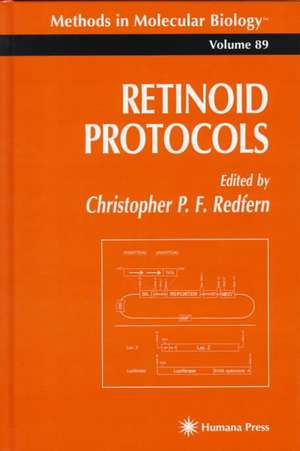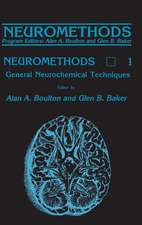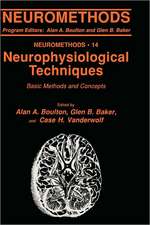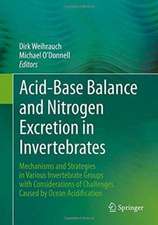Retinoid Protocols: Methods in Molecular Biology, cartea 89
Editat de Christopher Redfernen Limba Engleză Hardback – 16 ian 1998
| Toate formatele și edițiile | Preț | Express |
|---|---|---|
| Paperback (1) | 950.84 lei 6-8 săpt. | |
| Humana Press Inc. – 14 aug 2013 | 950.84 lei 6-8 săpt. | |
| Hardback (1) | 961.41 lei 6-8 săpt. | |
| Humana Press Inc. – 16 ian 1998 | 961.41 lei 6-8 săpt. |
Din seria Methods in Molecular Biology
- 9%
 Preț: 791.59 lei
Preț: 791.59 lei - 23%
 Preț: 598.56 lei
Preț: 598.56 lei - 20%
 Preț: 882.95 lei
Preț: 882.95 lei -
 Preț: 252.04 lei
Preț: 252.04 lei - 5%
 Preț: 802.69 lei
Preț: 802.69 lei - 5%
 Preț: 729.61 lei
Preț: 729.61 lei - 5%
 Preț: 731.43 lei
Preț: 731.43 lei - 5%
 Preț: 741.30 lei
Preț: 741.30 lei - 5%
 Preț: 747.16 lei
Preț: 747.16 lei - 15%
 Preț: 663.45 lei
Preț: 663.45 lei - 18%
 Preț: 1025.34 lei
Preț: 1025.34 lei - 5%
 Preț: 734.57 lei
Preț: 734.57 lei - 18%
 Preț: 914.20 lei
Preț: 914.20 lei - 15%
 Preț: 664.61 lei
Preț: 664.61 lei - 15%
 Preț: 654.12 lei
Preț: 654.12 lei - 18%
 Preț: 1414.74 lei
Preț: 1414.74 lei - 5%
 Preț: 742.60 lei
Preț: 742.60 lei - 20%
 Preț: 821.63 lei
Preț: 821.63 lei - 18%
 Preț: 972.30 lei
Preț: 972.30 lei - 15%
 Preț: 660.49 lei
Preț: 660.49 lei - 5%
 Preț: 738.41 lei
Preț: 738.41 lei - 18%
 Preț: 984.92 lei
Preț: 984.92 lei - 5%
 Preț: 733.29 lei
Preț: 733.29 lei -
 Preț: 392.58 lei
Preț: 392.58 lei - 5%
 Preț: 746.26 lei
Preț: 746.26 lei - 18%
 Preț: 962.66 lei
Preț: 962.66 lei - 23%
 Preț: 860.21 lei
Preț: 860.21 lei - 15%
 Preț: 652.64 lei
Preț: 652.64 lei - 5%
 Preț: 1055.50 lei
Preț: 1055.50 lei - 23%
 Preț: 883.85 lei
Preț: 883.85 lei - 19%
 Preț: 491.88 lei
Preț: 491.88 lei - 5%
 Preț: 1038.84 lei
Preț: 1038.84 lei - 5%
 Preț: 524.15 lei
Preț: 524.15 lei - 18%
 Preț: 2122.34 lei
Preț: 2122.34 lei - 5%
 Preț: 1299.23 lei
Preț: 1299.23 lei - 5%
 Preț: 1339.10 lei
Preț: 1339.10 lei - 18%
 Preț: 1390.26 lei
Preț: 1390.26 lei - 18%
 Preț: 1395.63 lei
Preț: 1395.63 lei - 18%
 Preț: 1129.65 lei
Preț: 1129.65 lei - 18%
 Preț: 1408.26 lei
Preț: 1408.26 lei - 18%
 Preț: 1124.92 lei
Preț: 1124.92 lei - 18%
 Preț: 966.27 lei
Preț: 966.27 lei - 5%
 Preț: 1299.99 lei
Preț: 1299.99 lei - 5%
 Preț: 1108.51 lei
Preț: 1108.51 lei - 5%
 Preț: 983.72 lei
Preț: 983.72 lei - 5%
 Preț: 728.16 lei
Preț: 728.16 lei - 18%
 Preț: 1118.62 lei
Preț: 1118.62 lei - 18%
 Preț: 955.25 lei
Preț: 955.25 lei - 5%
 Preț: 1035.60 lei
Preț: 1035.60 lei - 18%
 Preț: 1400.35 lei
Preț: 1400.35 lei
Preț: 961.41 lei
Preț vechi: 1172.45 lei
-18% Nou
Puncte Express: 1442
Preț estimativ în valută:
183.96€ • 192.59$ • 152.22£
183.96€ • 192.59$ • 152.22£
Carte tipărită la comandă
Livrare economică 05-19 aprilie
Preluare comenzi: 021 569.72.76
Specificații
ISBN-13: 9780896034389
ISBN-10: 0896034380
Pagini: 434
Ilustrații: XVI, 434 p.
Dimensiuni: 155 x 235 x 33 mm
Greutate: 0.9 kg
Ediția:1998
Editura: Humana Press Inc.
Colecția Humana
Seria Methods in Molecular Biology
Locul publicării:Totowa, NJ, United States
ISBN-10: 0896034380
Pagini: 434
Ilustrații: XVI, 434 p.
Dimensiuni: 155 x 235 x 33 mm
Greutate: 0.9 kg
Ediția:1998
Editura: Humana Press Inc.
Colecția Humana
Seria Methods in Molecular Biology
Locul publicării:Totowa, NJ, United States
Public țintă
Professional/practitionerCuprins
Handling and Analysis of Retinoids.- Properties of Retinoids.- Quantitative Analyses of Naturally Occurring Retinoids.- Detection and Measurement of Retinoic Acid Production by Isolated Tissues Using Retinoic Acid-Sensitive Reporter Cell Lines.- Retinoid-Binding Proteins.- Immunohistochemistry for CRBPs and CRABPs.- Whole-Mount In Situ Hybridization of Mouse Embryos Exposed to Teratogenic Levels of Retinoic Acid.- Reverse Transcriptase-Polymerase Chain Reaction (RT-PCR) for Cellular Retinoid-Binding Proteins.- Methods for Producing Recombinant Human Cellular Retinaldehyde-Binding Protein.- Expression and Purification of CRABPs from E. coli.- Purification and Fluorescent Titration of Cellular Retinol-Binding Protein.- Fluorometric Titration of the CRABPs.- Expression and Mutagenesis of Retinol-Binding Protein.- Interactions of Retinol-Binding Protein with Transthyretin and Its Receptor.- Detection of Conformational Changes in Cellular Retinoid-Binding Proteins by Limited Proteolysis.- Measurement of Rates of Dissociation of Retinoids from the Interphotoreceptor Retinoid-Binding Protein.- Use of Antisense Oligonucleotides to Study the Role of CRABPs in Retinoic Acid-Induced Gene Expression.- Nuclear Retinoid Receptors.- Preparation of Polyclonal Antibodies to Retinoid Receptors.- Detection of RARs and RXRs in Cells and Tissues Using Specific Ligand-Binding Assays and Ligand-Binding lmmunoprecipitation Techniques.- Nonisotopic In Situ Hybridization for the Detection of Nuclear Retinoid Receptor Transcripts in Tissue Sections.- In Situ Hybridization with 35S-Labeled Probes for Retinoid Receptors.- Isolation of Retinoid Receptors from Manimalian Cells.- Analysis of Retinoid Receptor Phosphorylation.- Photoaffinity Labeling of RARs and Mapping of Labeled Sites by an Endoproteinase Combination Technique.- PCR Cloning of N-Terminal RAR Isoforms and APL-Associated PLZF-RAR? Fusion Proteins.- RT-PCR in Diagnosis and Disease Monitoring of Acute Promyelocytic Leukemia (APL).- A Two-Hybrid Protein Interaction System to Identify Factors That Interact with Retinoid and Vitamin D Receptors.- Gel-Shift Analysis and Identification of RXREs and RAREs by PCR-Based Selection.- Identification and Cloning of RA-Regulated Genes by mRNA-Differential Display.- Gene Targeting of Retinoid Receptors.
Textul de pe ultima copertă
Christopher Redfern brings together in Retinoid Protocols a comprehensive collection of key biochemical and molecular methods for retinoid research. These easily reproducible techniques range from methods of handling and analyzing retinoids to advanced protocols for gene targeting, from binding protein function in transgenic animals to the study of nuclear retinoid receptors. In addition, the book makes accessible to all retinoid researchers such advanced techniques as cloning via RT-PCR, fluorimetry methods, recombinant protein purification and characterization, the use of antisense oligonucleotides to study the role of CRABPs, immunological and in situ hybridization methods, photoaffinity labeling, gel-shift analysis, and differential display.
Many of the chapters in Retinoid Protocols represent landmarks in retinoid methodology because they give step-by-step instructions for techniques central to understanding cellular control by retinoids. These indispensable techniques will be fundamental for all those working with retinoids, and so will play a key role in the development of new drugs and therapies for treating human disease.
Many of the chapters in Retinoid Protocols represent landmarks in retinoid methodology because they give step-by-step instructions for techniques central to understanding cellular control by retinoids. These indispensable techniques will be fundamental for all those working with retinoids, and so will play a key role in the development of new drugs and therapies for treating human disease.














